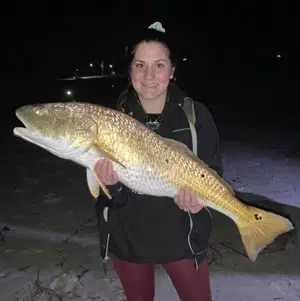PLEASE SHARE
WE ARE YOUR SOURCE FOR FISHING DESTINATIONS IN ALABAMA!
Night Fishing in the Surf for Bull Redfish

On summer nights, anglers can experience the thrill of catching bull redfish from shore. Surf fishing guide Matt Boyington’s dynamite technique produces big fish.
By Eileen Davis
Successful surf fishing guide Matt Boyington specializes in guiding anglers at night for bull redfish at least 40 inches long. For the past few years, many of his new and repeat customers have caught their biggest fish ever. One lady angler landed a 48-inch redfish one year, and then the following year, she caught a 49-incher. A fish this size weighs nearly 35 pounds. The guide’s biggest fish measured 51 inches.
“Night fishing is a lot more enjoyable than daytime,” Boyington said. “It’s an opportunity to catch a fish of a lifetime, and you do not have to worry about sea sickness or the expense of a chartered trip.”
Boyington’s business card reads Dixey Flats Surf Fishing Excursions. “The name has nothing to do with the Civil War,” he explained. “The name is from the legendary Dixey Bar known for its world-class red fishing.”
Submerged at the mouth of Mobile Bay, this famous sandbar stretches from the east side of the Mobile Ship Channel for nearly three miles to the tip of the Fort Morgan peninsula. It is named for the clipper ship Robert H. Dixey. In 1860, a hurricane destroyed the Dixey on the bar and 18 sailors died.
As the tides push bay or Gulf waters onto the Dixey Bar, it delivers a variety of forage to waiting predators. In combination with the deep water of the ship channel, it is an especially attractive environment to bull reds. The bar is an important factor in Boyington’s success, even though it’s not where he fishes.
Boyington continued, “The Dixey Bar is 200 yards off the beach and is only accessible by boat. However, there is another sandbar off the beach, and redfish use it as well. This sandbar, with its dropoffs, troughs and holes, changes with the tides and storms.
“Bull reds are lazy and are not going to chase baitfish. They will hold out of the current below the ledge of the sandbar or in adjacent troughs and holes. The redfish will congregate in these areas and wait for their next meal.”
Bait
To consistently catch bull reds, Boyington has found one type of bait outperforms all others.
“I catch more and bigger redfish in June through August,” he said. The key is using the right bait. With mullet, there are nights where it will catch fish, but the problem is like shrimp. Nearly everything in the Gulf will eat it, and there are a lot of sharks feeding on the sandbar and flats.
“For those reasons, I use blue and ghost crabs. Ghost crabs are like redfish candy. When reds have lockjaw, ghost crabs will produce strikes.”
Before hooking a ghost crab, Boyington removes the pincers and half the legs, which keeps the crab from burying in sand. For blue crab, he removes the points from the carapace and a back flipper. The guide fishes hand-size crabs whole, anything larger is halved with scissors. To hook a blue crab, Boyington threads the hook through the socket that held the back flipper and pushes it through the carapace near the white dot.
Tackle
To fish crabs from the beach, Boyington’s 10-foot rods have 5000 size reels spooled with 30-pound braid. His rods are rated for 3-ounce weights, which are an important factor in his fishing technique.
The main line is attached to a modified fish finder rig with two swivels. The rig is 50-pound monofilament, 6 inches long with a 3-ounce egg sinker sandwiched between beads and swivels. Boyington then adds an 8 to 12-inch leader with a 6/0 or 7/0 offset circle hook.
“This rig keeps the sinker from moving up your line,” he said, so the sinker does not become tangled in the line. This can be a serious problem when fighting a fish. The rig also keeps your bait on the bottom and in the strike zone of where the redfish are holding.”
To complete the setup, Boyington tapes a neon green glow stick to each rod tip to show strikes.
Presentation
“It is not necessary to wade out to cast your bait,” Boyington said. “We catch redfish from 20 to 100 yards from shore. Cast up current and allow the egg sinker to roll along the bottom. Eventually, it’s going to stop when it reaches one of the holes, and that is where you will find the redfish. You may have to make several drifts to find a productive current break. Once you find them, repeat the same cast.
“When the current is ripping, the fish stack up. But I do not increase my sinker weight, as the 3-ounce sinker offers a more natural presentation to the waiting fish. The only time I change the sinker is when there is very little current. In that situation, I reduce the weight to 2 ounces.”
Instead of putting out four rods and sitting down to wait on a bite, Boyington says fishing with crab bait is different.
“It is more hands on,” he said. “It’s necessary to set your drags loose. Redfish have crushers in the backs of their throats for crushing the crabs. I set the drag loose because if the fish feels any resistance they will drop the crab.”
Black Drum
“You never know what you are going to catch while night fishing off Fort Morgan,” Boyington said. “Black drum also love crab. There are a lot of black drum, and we catch as many as 20 a night. We have caught some that are close to a state record.”
To book a guided surf fishing trip with Matt Boyington, visit his Facbook page or call (251) 504-5049.
Read more about how successful anglers find and catch Bama’s bass.
